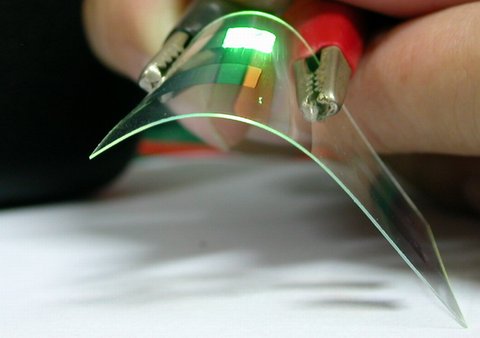Never content to rest on its laurels JetBlue Airways is eyeing the possibility of eventually moving to flexible OLED (organic light emitting diode) screens for its inflight entertainment systems. The low-cost carrier says it can also envisage a day when it might consider a purely wireless cabin.
During JetBlue’s recent A321 media preview, company director of product development Jamie Perry told RGN, “I do definitely see a future where streaming to devices instead of having the seat-back is there.
“Alternatively, I can also see a world where you have very, very small sort of OLED flexible screens that almost form part of the seat cover, and instead of cabling to the seat-back you stream to the seat-back, so there is a number of possible futures out there.”
Researchers have been studying ways to use flexible, plastic displays for years, and see opportunities for use in everything from smart phones and tablets to clothing and wall coverings.
As JetBlue keeps its eye on possible future travel experiences, the low-cost carrier recently rolled out the latest version of its live television system, a 100-plus channel LTV4 system developed by its former LiveTV unit, which was recently acquired by Thales. Perry says the carrier is looking to augment this IFE experience – and the carrier’s inflight high-speed Internet solution ‘Fly-Fi’ – by streaming content to passengers’ own devices and “definitely” thinks this “is in our short-term future”.
Separately, Perry confirmed that JetBlue is extending the beta period for Fly-Fi, which is supported by ViaSat’s high-capacity Ka-band Exede service. “We’re still testing and we don’t have the software ready to launch where we think we’re going to go to yet. We still have a lot of bugs, we know what they are; we are getting the bug fixes coded. We just need to get that thing totally stable 100% of the time,” says the JetBlue executive.
Asked by RGN to describe the problems, Perry revealed, “It’s a bit of everything. It’s a bit of connectivity, a bit of the [satellite] handover … None of it is particularly massive. “ He added that “nothing is changing in terms of what ViaSat gives us” in relation to Ka capacity.
Though JetBlue is eager to monetize its Fly-Fi offering, the carrier revealed it is considering continuing to offer a free element of the service when it comes off beta, as more and more passengers see connectivity as a human right. “So we have a lot of plans that are, I would say, in the works. What I can tell you is we’ve decided to extend the beta period beyond the end of June because we are not yet 100% sure how we are going to monetize. I suspect there will be some heavy tie-in with the True Blue and co-brand [credit] card programs and then the vast majority of the remaining monetization will come through content partnerships and sponsorships. What we have learned very clearly is that customers really appreciate free connectivity and their willingness to pay for access to connectivity is falling away,” he says.
“I’ve mentioned to you before, I know, that we have Starbucks to thank for getting customers to believe that Wi-Fi is costless and should be free everywhere, which may be one thing on the ground, but certainly in the air is not true so we do need to find a way to monetize the product, but I’m increasingly of the view that charging for access is not the way to do that. I think it is extremely likely there will be some level of free service after our beta period exits. We need to finish some testing we’re doing with LiveTV [Thales] right now, we need to firm up the monetization plans we’re working on, and build those into the portal we’re currently working on, so I would say it’s probably another few months away [before we leave beta].”
(Photo credit: By meharris (English Wiki) [GFDL (http://www.gnu.org/copyleft/fdl.html) or CC-BY-SA-3.0 (http://creativecommons.org/licenses/by-sa/3.0/)], via Wikimedia Commons)












